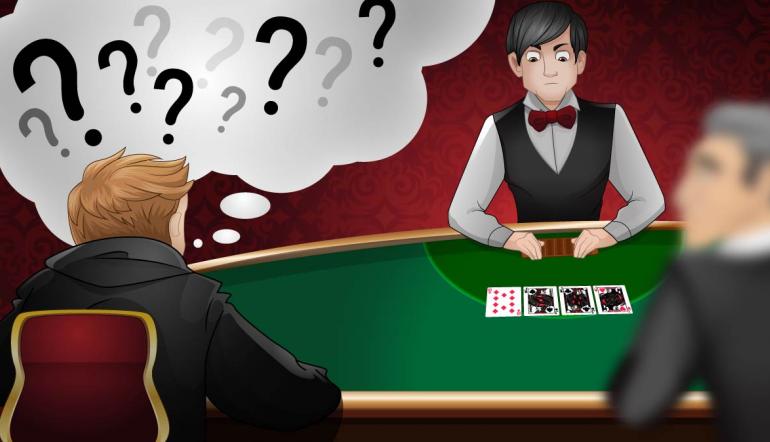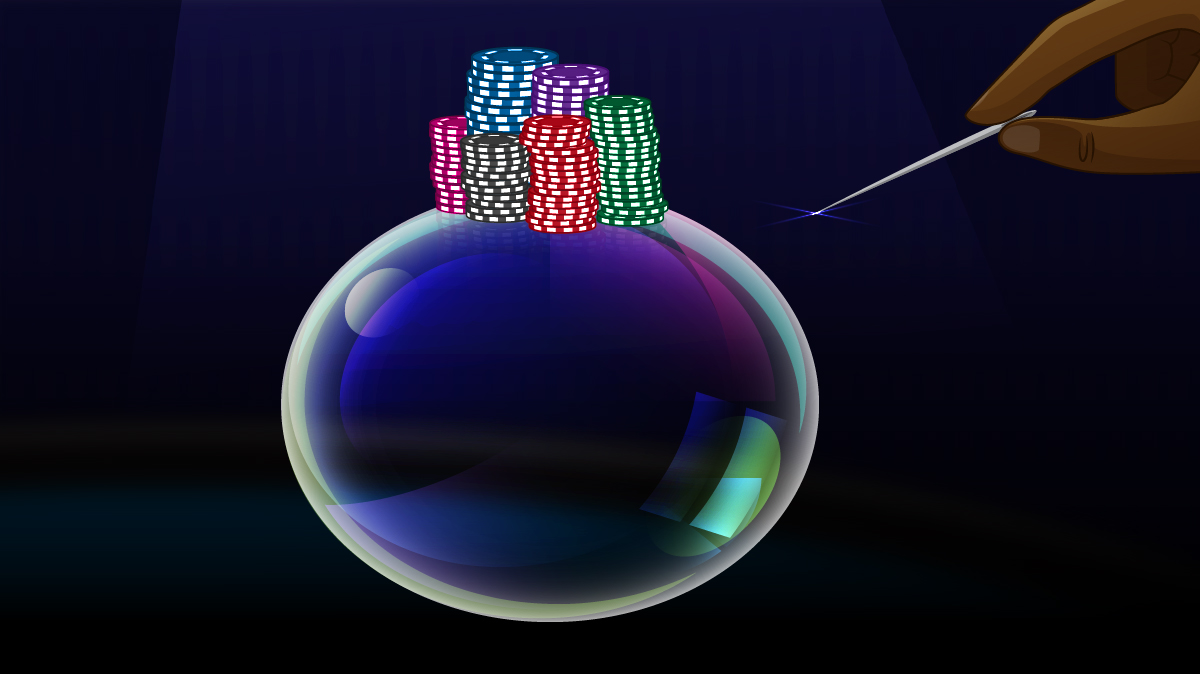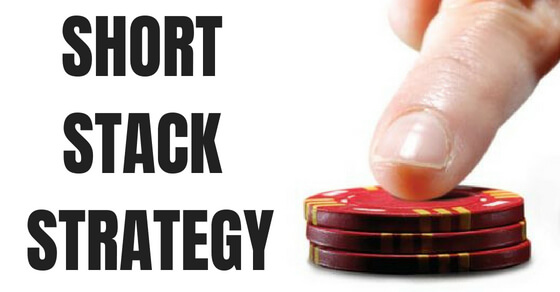Bubble Poker Strategy
Posted By admin On 26/03/22- Learn how to build a highly effective push-or-fold bubble strategy for the MTT tournaments by utilizing new capabilities of ICMIZER v2.10 in this video. This will revolutionize your tournament strategy in MTT tournaments with 100 or fewer players remaining.
- In a poker tournament, the bubble is the point in the tournament at which the next player out will not win any money, but the rest of the players will win money or cash. In other words, if the tournament pays out the top 27 players, when there are 28 people left, they are on the bubble.
Playing a midstack as the money bubble approaches is one of the most treacherous spots in poker. The standard advice is to play tight, and for good reason. The big stacks can afford to lose a big pot at this point in the game.
(This article is a follow up to 'Middle Stages Tournament Strategy')
To many tournament players, the bubble is a special time because it means all that hard work has almost paid off and it’s now time to get paid. After hours of grinding away and making difficult decisions, that initial investment is about to pay off. Great tournament players see the bubble a little differently. They simply see the bubble as one more opportunity on the way to taking first place and making the real money.
The “Increase Your Aggression” Strategy
90% of all tournament strategy on the internet tells you to amp up the aggression during the bubble in any MTT. The purpose is for you to increase your chip stack by stealing from all the players who have tightening up in the hopes of making it to the money-paying places.
The goal is to put yourself in a better position to win the tournament or at least make it to the final table. Barely making it through the bubble is not a winning strategy. For you to be a winning tournament player, you need to play for the win. The occasional big score is where all your tournament profits come from in the long run. The payouts are so skewed towards the final table that there’s really no point in playing to make it past the bubble.
By the time the bubble comes around, the blinds are so big that stealing them becomes the best way to build your chip stack. The blinds aren’t going to stop going up, either, so you need to use this opportunity to steal from all the players who have tightened up. That way, you’ll have a larger chip stack when the bubble breaks and have a better chance to place well in the tournament.
That’s All Correct, But…
Most tournament players are aware of the strategy we just discussed. You can safely bet that the majority of your opponents have typed in some form of the term “poker strategy” into Google at some point in the recent past. The strategy of stealing on the bubble isn’t exactly secret knowledge.
What Does This Mean For You?
It means that your opponents are aware of this strategy and are likely to adjust to it. Some of your more skilled opponents will know that when you come alive during the bubble, it’s because you have read the same strategy as they. Some of these opponents will then re-adjust their strategy to suit yours – namely they’ll attempt to steal your steals by putting in big re-raises.
The best way for you to continue to be productive during the bubble is to pay close attention to each of your opponents. You can tell which opponents know how to play the bubble and which ones don’t. You can then tailor your strategy to each specific opponent.
For example, you can tighten up against the aggressive players who try to steal your re-steals. That way you’ll have a nasty surprise for them the next time they try to steal one of your preflop raises. You can also watch how they react to re-steals. Some of these players will give up every time you 3-bet them before the flop.
4-Bet bluffing aggressive players is usually out of the question because the blinds are so large in comparison to the average stack size. Even a small 3-bet raise is usually enough to become pot-committed. In cash games, I would suggest the rare 4-bet bluff but in tournaments, it’s just not feasible.
Bubble Play Poker Strategy
Once you have the smart, aggressive players identified, you can then single out the weak, tight players. Against those players, you can use the same old strategy of stealing their blinds every chance you get.

Taken separately, these two approaches to dealing with different types of opponents are pretty simple. The difficulty is in using both approaches at the same table and not getting them all mixed up. Playing two different styles at the same table requires a great deal of effort and concentration. The good news is that if you’re willing to work hard, you will make a lot of money in MTTs.
Now that you know how to play the bubble, learn how to play the late stages.

More General Poker Tournament Strategy:
17:1414 Jun
There is nothing worse than making good progress through the early and middle stages of a poker tournament, and carefully amassing a large stack with solid play and well-executed bluff, only to be eliminated just short of the money without even a small cash to show for all your hard work. The larger the tournament, the worse this feels but now you resolve to get better and commit to learning how to beat the bubble.

The bubble is defined by Pokerzone’s poker dictionary as follows:
The point in a tournament at which there are only slightly more players remaining than there are finishing positions that receive a prize.”
Bubble Poker Strategy Free
In practice this means that as the money approaches, there is a psychological shift in how poker players approach the game. They do not want to bust and leave with nothing so they play more conservatively and hope someone else busts.
There is no precise moment the bubble begins, so you need to observe the other players behavior and once players start to check the tournament board to see how many players are left, start talking about the bubble, and begin to play less hands, then you know the dynamic has changed and you are into the bubble phase of the tournament. Here are five tips that will help you prevent busting out of the tournament on the bubble.

Play The Stack
Playing the stack is as much about your stack as it is your opponents. You should always be aware of the size of your opponents stack in relation to your own, but on and around the bubble this is particularly important. If your opponent has a large stack, they may play back at you because they know the last thing you want is to finish outside of the money. If they have a short stack, you can bully them out of a hand because they are clinging on and the correct thing is to survive for as long as possible as opposed to gambling. If they play back at you, they either have the goods or they are very brave. Such is the nature of bubble play, they usually have a strong hand.
If your stack is short you need to cling on too, so playing with speculative hands or chasing draws is unwise. Let others players be brave and take silly risks. Min-cashing is never your goal at the beginning of a tournament, but can be +EV providing you do not aim to min-cash in every tournament and always play to win.
Pressure When in Position
After checking your opponents stack size as per our first tip, note that more players fold hands during the bubble, so take every advantage when acting first to raise the pot. Your show of strength forces opponents to make a decision as to whether their hand is strong enough to play against you. Many players only play premium hands at the bubble stage as they want the best chance to win a big pot but they do not want to take big risks.
Remember, the last thing anyone wants is to finish on the bubble so you can bully players a little more often. Observation is key. If you see a player tighten up and get nervous make a note of this and use it to your advantage.
Bubble Poker Strategy Printable
Vary Your Play
Attacking players with a certain stack size and always raising when first into the pot to show how fearless you are is easily detected. Noting your new approach, players can play back at you knowing that as a good player you will know to take fewer risks at this stage of the tournament.
Do not give too much away by attacking the same player over and over. An 8x the big blind shove will still dwindle a stack or force you to fold non-premium hands. If you overdo it and frustrate an opponent, they can think they have no choice but to fight back. If you are re-raised and your play has not worked just fold and move on. There will be better spots to make money than to engage in handbags at dawn with a tenacious opponent.
Remember What Wilson Phillips Said - Hold on!
With the shortest of stacks, think of the popular Wilson Phillips song as you sit there trying to survive. At any other stage of the poker tournament you should not dwindle your stack to the point where even doubling up does not help you very much. At the bubble, however, it is a good idea to hold on for dear life and try to survive. A min-cash is better than nothing, and the damage was done earlier in the tournament when, for whatever reason, you were unable to build a large stack so you could have avoided your current predicament. If you get AA or KK (I will leave AK and QQ as your call!) you can go all-in. Otherwise a chip and a chair might be your ticket to winning a little money.
Bubble Poker Strategy Chart
Don’t Play Too Conservatively

Bubble Poker Strategy Game
Poker is a game where two different situations call for contradictory strategies. Having a very small stack will happen, but you should do all you can to maintain your stack as the bubble approaches. Players can be resolute in avoiding busting around the bubble so there are often many rounds of play before the bubble bursts. Going through the blinds again and again can quickly deplete your stack. Look for spots to steal to ensure your stack does not dwindle. Whilst busting at the bubble stage is a bad thing, our major goal is to maintain a stack large enough to allow us to make a surge towards the final table.
At the WSOP Main Event, where the smallest cash is usually $14,000 - $18,000, some players fold AA rather than risk going bust. This is understandable if they won their seat in a satellite, for example, but as a general rule folding every hand around the bubble in every tournament you play will really harm your long-term results.
Once the bubble bursts you will see a flurry of play as the tiny stacks quickly bust out. They knew it was coming but they wanted to hold on for the small cash. Hopefully you have picked up some tips so you can maintain a good stack to allow you to successfully negotiate the bubble then make your move towards the final table and towards the big cash prizes you should always be aiming for.